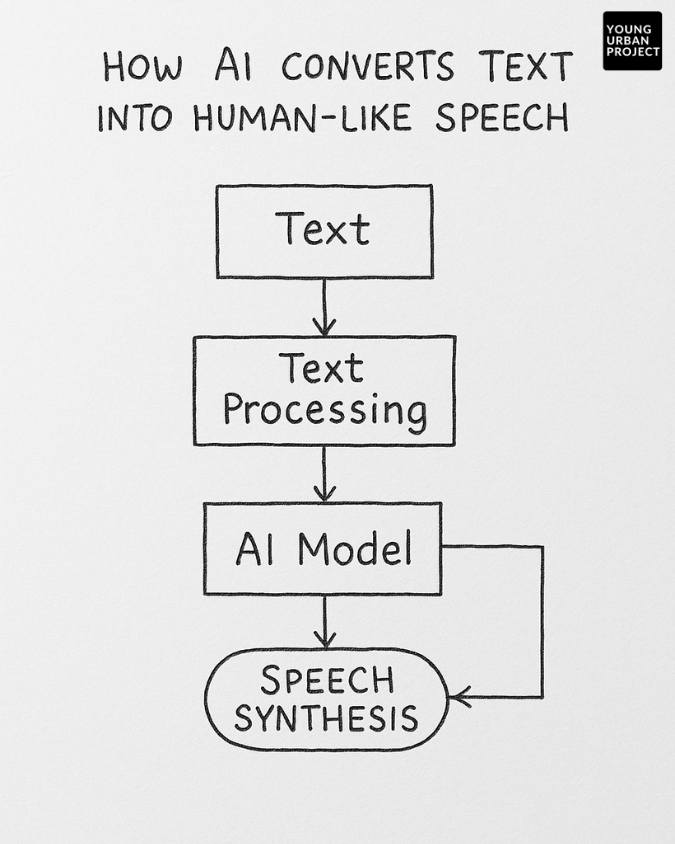Let’s be honest, voiceovers can be a huge pain.
You’ve got to find the right voice actor, send scripts back and forth, maybe go through a few awkward revisions, and if you’re on a deadline? Good luck.
But in the last couple of years, something’s changed. A new wave of AI voiceover tools has started replacing that entire process, and not in a cheap, robotic way either. These tools are starting to sound… kind of real. In some cases, eerily real.
And for content creators, marketers, educators, and pretty much anyone making videos or audio content, it’s opened up a whole new world of speed, flexibility, and reach.
Table of Contents
So, What Exactly Are AI Voiceover Tools?
In simple terms, AI voiceover tools turn written text into spoken words. But not like those stiff, outdated text-to-speech bots we all remember from the early internet. No, these tools use some serious AI tech, like deep learning models and neural networks, to replicate human voices with surprising accuracy.
You type. The software speaks. And in most cases, it actually sounds like a real person.
What’s even more wild is that some of these tools let you clone your own voice. You record a few samples, and after that, you can generate any script in your own tone, accent, and pacing, without opening your mouth again. It’s both fascinating and slightly freaky.
How Do AI Voice Generators Actually Work?
Alright, quick breakdown, without diving too deep into the tech jungle.

At the heart of these tools is something called text-to-speech, or TTS. Combine that with deep learning, and you get software that doesn’t just read your words, it tries to understand how a human would say them.
That means natural pauses, emotion, rhythm, and tone. Some tools can even add laughter, sighs, or different speaking styles (like casual vs. formal). It’s not perfect across the board, but honestly? Some of the results are better than amateur voice actors.
And like I mentioned earlier, voice cloning is becoming a big deal. Tools like ElevenLabs or Descript let you feed in audio samples, and then they basically build a digital version of your voice.
Imagine turning an entire blog post into a podcast in your voice, without recording a thing. That’s not science fiction anymore.
Why Creators Are Switching to AI Voiceover Tools in 2025
There are a few big reasons creators are leaning into this tech, especially now that the quality has caught up to the hype.
1. You Save Time and Money. A Lot of It.
Hiring a voiceover artist takes time. And if you’re on a budget, it gets expensive, fast. AI voice generators let you skip all of that. Just input your text, choose a voice, and you’ve got a clean, professional audio file in minutes.
And if you need to make changes? No problem. No awkward re-recordings or coordination needed.
2. You Can Scale Content Without Burning Out
If you’re a YouTuber, online educator, or marketer producing content regularly, you know how hard it is to keep up. AI tools make it easy to pump out narrations for multiple projects without sacrificing quality (or losing your voice).
This is especially useful for creators managing content across YouTube, Reels, podcasts, blog videos, you name it.
3. Multilingual Options Open Up Global Reach
A lot of AI voice tools now support dozens, even over 100, languages and accents. Want to turn your English course into a Spanish or Hindi version? You can do that. It’s a huge win for anyone looking to grow internationally without having to hire translators or multilingual voice talent.
4. Consistent Quality Every Time
Let’s be real, even the best human voice actors have off days. With AI, you get the same tone, delivery, and pacing every single time. That kind of consistency is gold when you’re trying to maintain a certain brand sound or voice across platforms.
The Top 10 AI Voiceover Tools of 2025
Alright, let’s get into the good stuff. There are a lot of tools out there, but here are ten that are really standing out this year, each with its own strengths depending on what you’re trying to do.
1. Fiverr Go – Best for Hybrid AI + Human Voiceovers
This one’s interesting because it blends tech with a human touch. Fiverr Go lets you generate AI voiceovers, but then it pairs them with professional human editors who polish the final product. It’s ideal for creators who want the speed of AI but don’t want to lose the warmth and polish of a human voice.
Think ad agencies, branded content, promo videos, anywhere tone matters.
2. ElevenLabs – Best for Voice Cloning and Audiobooks
This tool has been making waves because of how real its voices sound. It also gives you advanced controls for emotion, tone, and pacing, which makes it perfect for audiobooks, storytelling, or any kind of long-form narration.
You can even create your own synthetic voice model and use it across projects. Honestly, if you’re serious about audio, ElevenLabs is a must-try.
3. Listnr – Best for Podcasters and Video Creators
Listnr is built with video creators in mind. It supports over 75 languages, offers background music options, and even includes podcast hosting. If you’re running a one-person media operation, this can handle a good chunk of your production pipeline.
Bonus: the interface is super clean and beginner-friendly.
4. Murf.ai – Best for Script Control and Editing Flexibility
Murf feels more like a mini production suite than just a voice tool. It gives you options to adjust pitch, speed, add pauses, and fine-tune your script. There’s even support for team collaboration, which is perfect if you’re working with clients or a small content team.
You also get access to a library of royalty-free background music. Solid pick for anyone doing e-learning, training videos, or YouTube tutorials.
5. Fliki – Best for Turning Blog Posts Into Voice-Over Videos
This one’s made for content marketers. If you’ve got a blog post or script, Fliki turns it into a video with AI narration, visuals, and music in just a few clicks. It’s not going to replace a full video editor, but for repurposing written content into something visual and engaging? It’s fantastic.

Enroll now: Ai Marketing Course
6. Synthesia – Best for Video Tutorials with Avatars
Okay, this one goes a step further.
Synthesia doesn’t just give you a voice, it gives you a full AI avatar that can read your script on screen, almost like a real presenter. It’s kind of wild the first time you see it in action.
This makes it perfect for explainer videos, onboarding content, or online courses, especially if you don’t love being on camera yourself. You just upload a script, pick an avatar and voice, and boom: your video’s ready in minutes.
They also support multiple languages and you can even create your own custom avatar (though that part’s usually for enterprise-level users).
7. Descript Overdub – Best for Voice Cloning + Audio Editing
Descript is already a go-to for podcasters and YouTubers, but its Overdub feature is next-level.
Here’s the magic: you can train it on your voice and then edit your audio just by typing. Messed up a line? You don’t have to re-record it, just change the words in the script and your cloned voice will fill it in. Clean, seamless, kind of spooky (but in a good way).
It’s a total time-saver for creators who want more control without diving into audio editing software. Also great for fixing mistakes after you’ve already recorded.
8. WellSaid Labs – Best for Corporate Training and Ads
If you’re in the business world, think internal training videos, explainer clips, or branded content, WellSaid Labs is one of the more polished tools out there.
Their voices feel premium. Like, really premium. They don’t just speak clearly; they sound confident, natural, and professional. A lot of L&D (learning and development) teams use this because it’s efficient, scalable, and the results don’t feel robotic at all.
Also worth noting: their commercial usage licensing is super clear, which makes it safe to use in any professional context.
9. Play.ht – Best for Quick TTS and Embeddable Audio
Need to turn a blog post into audio, fast?
Play.ht is built for that. You paste in your text, choose a voice, and you’ve got a clean audio file in seconds. One cool feature: you can embed the audio directly into your website so readers can listen instead of reading.
Great for accessibility, or for giving your audience a different way to consume your content. It also supports multiple languages and even has a free tier, which is nice if you’re just testing the waters.
10. Lovo.ai – Best for Creative Projects and Storytelling
If you’re working on anything a little more creative, think animation, gaming, storytelling, or even audiobook projects, Lovo is worth checking out.
It’s not the most corporate-looking tool, and that’s the point. The voice styles here are expressive, emotional, and in some cases, a little dramatic (in a good way). You can also tweak settings like pacing and emphasis to get your delivery just right.
Some indie game developers have started using it to voice NPCs, and creators love it for narrative YouTube channels or kids’ content.
Also Read: Content Marketing Tools
Top AI Voiceover Tools Comparison Table (2025)
| Tool | Best For | Voice Quality | Free Plan | Notable Features |
|---|---|---|---|---|
| Fiverr Go | Human-AI hybrid voiceovers | ⭐⭐⭐⭐☆ (Hybrid) | ❌ | Combines AI with real voiceover artists, quality-checked by humans |
| ElevenLabs | Audiobooks & voice cloning | ⭐⭐⭐⭐⭐ | ✅ (limited) | Emotion control, multilingual support, custom voice training |
| Listnr | Podcasts & video narration | ⭐⭐⭐⭐☆ | ✅ | 75+ languages, podcast hosting, embeddable audio player |
| Murf.ai | Script editing & customization | ⭐⭐⭐⭐☆ | ✅ | Pitch & pause control, voice styles, team collaboration |
| Fliki | Blog-to-video/audio conversion | ⭐⭐⭐⭐ | ✅ | Turns text or blogs into voiceover videos with visuals and music |
| Descript Overdub | Voice cloning & editing | ⭐⭐⭐⭐☆ | ✅ | Clone your voice, edit audio like text, multitrack studio tools |
| Synthesia | AI avatars with voiceover | ⭐⭐⭐⭐ | ❌ | Talking avatars, subtitle generation, multilingual support |
| WellSaid Labs | Professional ads & training videos | ⭐⭐⭐⭐⭐ | ❌ | Studio-grade voices, ideal for corporate training and commercial ads |
| Play.ht | Embeddable TTS & articles | ⭐⭐⭐⭐ | ✅ | Natural-sounding voices, audio for blogs, RSS feeds, and websites |
| Lovo.ai | Creative storytelling & gaming | ⭐⭐⭐⭐☆ | ✅ | Emotion-rich voices, background music, advanced audio mixing tools |
Also Read: 52 Best Affiliate Marketing Tools
Real-World Use: Where AI Voiceovers Are Already Winning
This stuff isn’t theoretical anymore. You’re already hearing AI voiceovers in places you probably didn’t even realize.
- Duolingo, for example, uses AI to teach pronunciation across tons of languages. It feels like you’re being coached by a native speaker, even though it’s all synthetic.
- Spotify Ads Studio now lets small businesses create voiceover ads with AI. You write the script, pick a voice, and you’ve got a professional ad in minutes.
- Medium.com offers a “Listen” button for many of its articles, powered by TTS. Perfect for people who want to absorb articles while driving or walking.
- And then there’s YouTube. Channels like “Future Unity” or “The Infographics Show” are using AI narration to push out high-quality videos daily, sometimes multiple per day. It’s becoming the norm in high-volume content production.
Also Read: Best WhatsApp Marketing Software Tools
What Should You Actually Look For in an AI Voice Generator?
Let’s be honest: the features list on some of these platforms can get a little overwhelming. But if you’re a creator, marketer, educator, or anyone trying to put together good-sounding content, you really only need to focus on a few key things.
Here’s what actually matters:
1. Voice Realism
If it doesn’t sound like a real person, what’s the point?
Listen to a few samples before committing. Some tools do a better job with natural pacing, breathing, and tone shifts. The difference between a passable voice and one that actually connects with your audience is huge.
2. Voice Cloning (If You’re Building a Personal Brand)
Want your content to sound like you without needing to record every word? Voice cloning is where it gets fun. Tools like Descript and ElevenLabs let you train a model on your voice, and from there, you just type and your digital self does the talking.
It’s a little weird at first, but incredibly useful.
3. Language & Accent Options
If you’re trying to reach a global audience (or even just one outside your native language), multi-language support is a game-changer. Good tools let you pick not just the language, but regional accents and tone styles.
4. A Solid Editing Dashboard
This is more important than people think. Having the ability to tweak speed, pitch, pauses, and pronunciation can save hours in post-production. Some tools even let you insert breaks or emphasize certain words, super helpful when tone matters.
5. Commercial Use Rights
Not exciting, but critical. If you’re monetizing your content, ads, paid courses, client projects, make sure the tool gives you the legal green light. Some of the free plans don’t come with commercial usage, so always double-check.
6. Integrations (Zapier, API, etc.)
This is more of a bonus, but it’s worth mentioning. If you’re running automated workflows, or you want to embed audio directly into your website, having API access or Zapier integrations can make life easier. Especially for content teams.
Also Read: Top 30 AI Tools for Digital Marketing
5 Real Problems AI Voice Tools Are Solving Right Now
This isn’t just about convenience. AI voice generators are solving actual problems for real people, especially solo creators and small teams. Here’s what they’re helping with:
1. High Voiceover Costs
Hiring voice actors isn’t cheap. If you’re cranking out content regularly, those costs add up fast. AI voice tools give you studio-quality audio without needing to pay by the hour, or per revision.
2. Time Constraints
Whether you’re working on client deadlines or just trying to keep up with your own publishing schedule, recording voiceovers can slow you down. With AI, you can generate clean audio in minutes. No retakes. No background noise ruining your session.
3. Scaling Content Across Platforms
You might have a YouTube video, a blog, a podcast, a short-form reel, all needing audio. Doing that manually? Exhausting. AI voice tools let you scale up fast, without sacrificing consistency.
4. Inconsistent Delivery
Even great voice actors have off days. Maybe they’re tired, maybe they’re under the weather. AI voices don’t have bad days. You get the same tone, cadence, and energy every time.
5. Limited Access to Voice Talent (Especially in Other Languages)
Not everyone has access to native speakers or multilingual voice actors. AI opens up access to voices in dozens of languages and dialects, which is huge if you’re trying to localize your content or expand your audience internationally.
Also Read: Best AI SEO Tools to Boost Rankings
Free vs Paid AI Voiceover Tools: What’s Actually Worth It?
Here’s the truth: free AI voice tools are great, for testing.
If you just want to try things out, experiment with a few voices, or create something for personal use (like a side project or social content), the free tiers from tools like Fliki, Play.ht, or Listnr can absolutely do the job.
But if you’re creating content at scale, or anything remotely professional or monetized? You’ll probably outgrow the free plans fast.
What You Get With Paid Tools:
- Better voice quality (more human, less “AI-ish”)
- Commercial usage rights (super important if you’re selling or promoting anything)
- Advanced editing controls (pitch, pacing, pauses, emotion)
- Access to premium voices that sound way more realistic
- Faster processing and no watermarking
Bottom line?
Use the free plans to get a feel for things. But if you’re building a serious content workflow, or representing a brand, it’s worth investing in a tool that sounds the part.
Also Read: 30 Keyword Research Tools for Every Use Case
Final Thoughts
Here’s the thing.
AI voiceover tools aren’t just some trendy gimmick or productivity hack. They’re part of a much bigger shift in how we create content. A few years ago, you needed a full studio setup, or a decent budget, to produce professional audio. Now? You can get close to the same quality from your laptop… in minutes.
But that doesn’t mean the tech is perfect. You still need a good script. You still need to understand your audience. And you still need to use your judgment, not every AI voice fits every message. Sometimes, a human voice still hits harder.
But when used right?
These tools can seriously level up your workflow. They help you move faster, test ideas quicker, and make your content more accessible across platforms, languages, and formats.
So whether you’re narrating your first YouTube video, turning blog posts into podcasts, or scaling internal training for a remote team, AI voiceovers aren’t replacing you. They’re supporting you. Helping you do more of what you’re great at.
And honestly? That’s kind of exciting.
FAQ: AI Voiceover Tools
Q1. What’s the best AI voice tool for YouTube narrations?
Honestly, Murf.ai is a strong all-rounder for YouTubers. But if you want something more emotional or dramatic (think storytelling channels), ElevenLabs is hard to beat. Also, Descript Overdub is amazing if you want to use your own voice.
Q2. Are there free AI voice generators that aren’t total junk?
Yep. Fliki and Play.ht both have decent free versions. You won’t get full features or commercial rights, but they’re more than enough to experiment or use for personal projects.
Q3. Which tool sounds the most human?
Right now? ElevenLabs probably takes the crown in terms of natural tone and emotional nuance. WellSaid Labs is a close second, especially for polished, professional voices.
Q4. Can I clone my own voice with AI?
Yes, and it’s kind of incredible. Descript Overdub and ElevenLabs both let you train a voice model on your own voice. You just upload a few samples, and after that, you can generate speech in your voice, just by typing.
Q5. Is it legal to use AI voices for commercial stuff?
Mostly yes, as long as you’re using a paid plan that includes commercial rights. Always double-check the terms before you publish, especially if it’s client-facing or monetized content.

